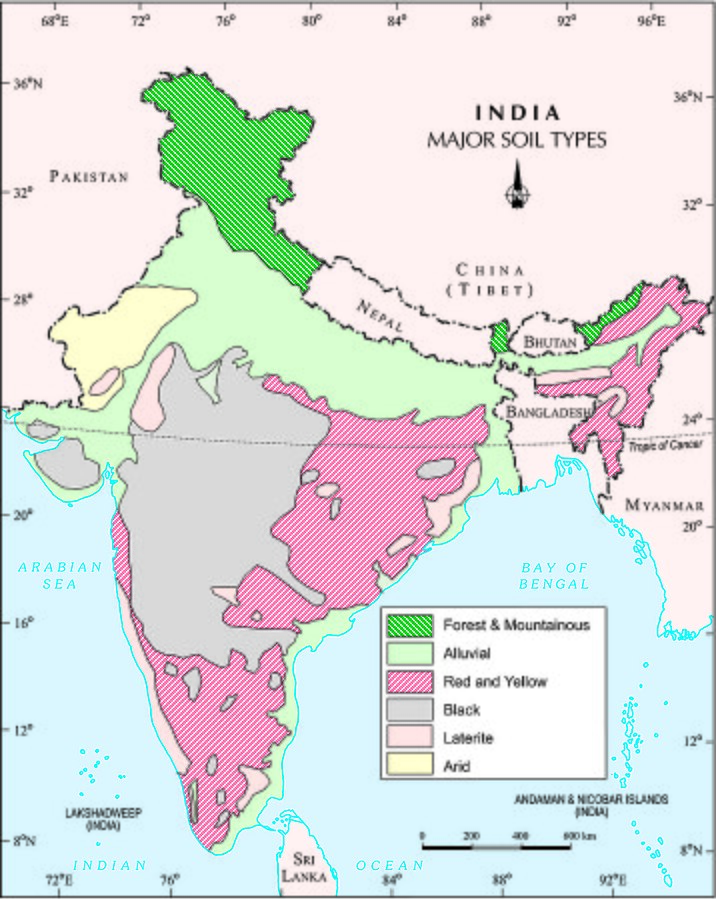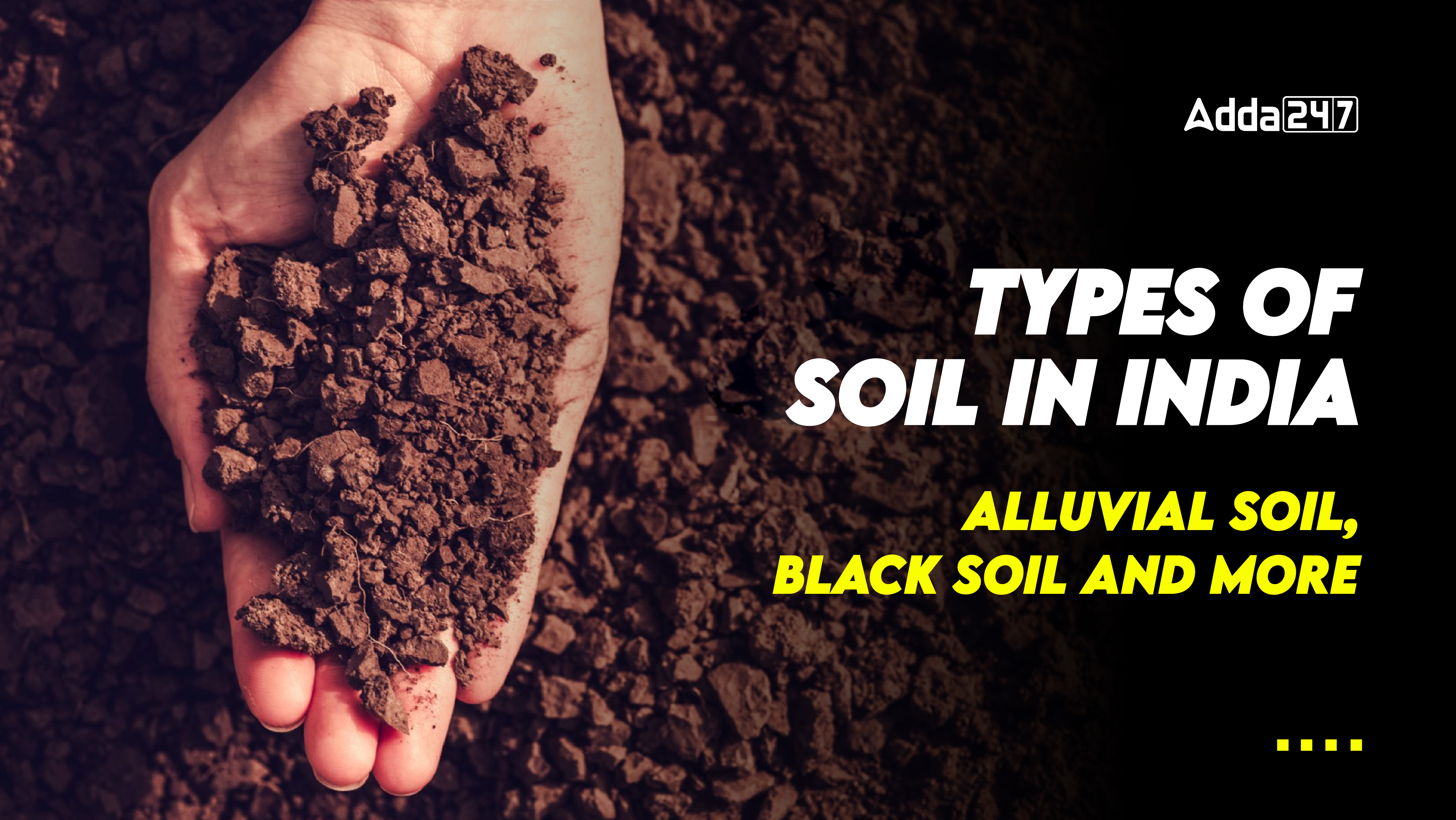India has many different types of soil, shaped by the climate, land, and rocks beneath. For example, the rich soil in river plains is great for growing rice and wheat, while sandy soil in dry areas is not very good for farming. Knowing about these different soils helps farmers pick the right crops and care for their land better.
In this article, we’ll look at the various kinds of soil in India, where they are found, and why they matter. It’s like discovering the different colors in a beautiful painting that makes up India’s landscape.
What is Soil?
Soil is the thin layer on the Earth’s surface made up of tiny rock particles and organic matter called humus. This layer, part of the Earth’s crust, contains small rock fragments and essential nutrients needed for plant growth. In the past, soils were mainly categorized by their fertility, and the two primary types based on fertility were:
- High Fertile- Urvara
- Low Fertile- Usara
Profile of Soil
As you dig a hole straight through the Earth, you will encounter different layers of soil, each with its characteristics. These layers make up what is called the soil profile. Here’s a simple breakdown of the soil layers from the surface to the bedrock:
| Soil Profile | |
|---|---|
| Soil Layer | Description |
| Topsoil (O Horizon) | The uppermost layer- where plants grow and organic matter decomposes. It’s dark and rich in nutrients. |
| Subsoil (A Horizon) | Beneath the topsoil, it’s denser and may have fewer nutrients, but plant roots can still penetrate it. |
| Parent Material (B Horizon) | Made up of weathered rock fragments and minerals. Contains less organic matter than the layers above it, formed from the breakdown of the bedrock below. |
| Weathered Bedrock (C Horizon) | The layer closest to solid bedrock. It contains little to no organic matter and is made of partially weathered rock material. |
Classification of Soil
Various organizations work together to study, classify, and manage soil resources in India. These are:
| Location | Organization | Role |
|---|---|---|
| New Delhi | Indian Council of Agricultural Research (ICAR) | Leads agricultural research and education, including soil science. |
| Nagpur, Maharashtra | National Bureau of Soil Survey and Land Use Planning (NBSS&LUP) | Maps soil resources and plans land use. |
| Bhopal, Madhya Pradesh | Indian Institute of Soil Science (IISS) | Conducts soil research and education under ICAR. |
| – | State Agricultural Universities (SAUs) | Conduct research and education on local soil resources and agriculture. |
| – | State Departments of Agriculture | Implement agricultural policies and promote soil conservation practices. |
| Panchkula, Haryana | Central Soil and Water Conservation Research and Training Institute (CSWCRTI) | Conducts research and training on soil and water conservation. |
| Kolkata (HQ) | Geological Survey of India (GSI) | Conducts soil surveys and provides geological information, including soil data. |
Types of Soils in India
According to the Indian Council of Agricultural Research (ICAR), there are majorly 8 different types of soils in India. These are:
- Alluvial Soil
- Red Soil
- Black Soil
- Desert Soil
- Laterite Soil
- Mountain Soil
- Saline and Alkaline Soil
- Peaty and Marshy Soil

Let’s get more information about each type of soil.
Alluvial Soil
These are created by silt carried by rivers like Indo-Gangetic-Brahmaputra and coastal wave action.
| Aspect | Details |
|---|---|
| Coverage in India | Covers about 46% of India’s land, supporting over 40% of its population. Found throughout the Indo-Gangetic-Brahmaputra plains, except desert areas. Also in Narmada, Tapi valleys, and parts of Gujarat. |
| Characteristics | Alluvium in India’s Great Plain is divided into newer khadar and older bhangar soils. Young and not fully developed; mostly sandy texture with some clay. Varies from loamy to sandy loam. |
| Types |
|
| Chemical Properties | Low in nitrogen but rich in potash, phosphoric acid, and alkalies. Iron oxide and lime content can vary. |
| Suitable Crops | Rice, wheat, sugarcane, tobacco, cotton, jute, maize, oilseeds, vegetables, and fruits. |
| Special Features | High fertility makes it suitable for intensive agriculture.
Vulnerable to waterlogging and salinization. Important for rice cultivation due to its ability to retain water. |
Red Soil
These are formed by the weathering of crystalline rocks.
| Aspect | Details |
|---|---|
| Coverage in India | Found in regions with a tropical climate, such as parts of Tamil Nadu, Karnataka, Andhra Pradesh, and Maharashtra. Predominantly found in southern and central India, covering about 10% of the country’s land area. |
| Characteristics | Generally sandy or loamy texture, often red or yellow. Less fertile compared to other soil types. |
| Types | Laterite Soil: Predominantly found in the Western Ghats, Eastern Ghats, and parts of northeastern India. |
| Chemical Properties | Low in organic matter, nitrogen, phosphorus, and calcium. Often rich in iron oxide and aluminum oxides. |
| Suitable Crops | Suited for crops like millets, pulses, oilseeds, and some cash crops with proper fertilization and management. |
| Special Features | Prone to erosion and leaching due to low clay content.
Requires careful management to maintain fertility. |
Black Soil (Regur Soil)
These are formed from the weathering of basaltic rocks such as lava flows.
| Aspect | Details |
|---|---|
| Coverage in India | Covers about 15% of India’s land area, mainly in central and southern India. Found in the Deccan Plateau region, particularly in Maharashtra, Madhya Pradesh, Gujarat, and parts of Karnataka. |
| Characteristics |
|
| Types | Deep Black Soil: Dark in color, high fertility, found in areas with more rainfall.
Shallow Black Soil: Shallower depth, less fertile. |
| Chemical Properties | High in calcium, magnesium, and lime content. Moderately fertile with good moisture retention properties. |
| Suitable Crops | Well-suited for crops like cotton, sorghum, millets, pulses, and oilseeds. |
| Special Features | Prone to cracking during dry seasons, which aids in aeration.
Requires proper management to prevent soil erosion. |
Desert Soil
These are formed by the weathering of rocks and minerals in arid and semi-arid regions with limited vegetation and rainfall.
| Aspect | Details |
|---|---|
| Coverage in India | Found in regions with low rainfall, such as Rajasthan, Gujarat, and parts of Haryana. |
| Characteristics | Sandy texture with low organic matter content. Often saline and alkaline due to evaporation of water. |
| Types | Arid Soil: Extremely dry soil is found in hot deserts like the Thar Desert.
Saline Soil: Soil with high salt content due to evaporation in arid regions. |
| Chemical Properties | High levels of calcium, magnesium, and salts. Poor fertility due to lack of organic matter and nutrients. |
| Suitable Crops | Limited agricultural potential; mainly used for drought-resistant crops like millets and pulses. |
| Special Features | Susceptible to wind erosion and desertification.
Requires special irrigation techniques for agriculture. |
Laterite Soil
These are formed from the weathering of rocks and minerals in tropical and subtropical regions with high rainfall.
| Aspect | Details |
|---|---|
| Coverage in India | Predominantly found in the Western Ghats, Eastern Ghats, and parts of northeastern India. |
| Characteristics | Typically red or orange in color, with a high proportion of iron and aluminum oxides. Often hard when dry. |
| Types | Red Laterite Soil: Rich in iron oxides, giving it a reddish color.
Yellow Laterite Soil: Lower iron content, appearing yellowish. |
| Chemical Properties | High in iron and aluminum oxides, but low in fertility and organic matter. Acidity can vary. |
| Suitable Crops | Generally not suitable for agriculture due to poor fertility, but used for cashew plantations in some areas. |
| Special Features | Hardens when dry, making it difficult to cultivate.
Used for road construction and brick-making. |
Mountain Soil
These are formed through the weathering of rocks and minerals in mountainous regions due to factors like erosion and glaciation.
| Aspect | Details |
|---|---|
| Coverage in India | Found in the Himalayan region and other mountain ranges across the country. |
| Characteristics | Variable texture and composition depending on altitude, slope, and parent material. Often rocky and shallow. |
| Types | Podzols: Found in high-altitude regions with acidic soil and leached topsoil.
Lithosols: Shallow soils with rocky or stony layers, common in steep slopes. |
| Chemical Properties | Varies widely depending on local conditions. Typically acidic, with low organic matter content and nutrients. |
| Suitable Crops | Limited agricultural potential due to rocky and shallow nature. Some terrace farming practices are adopted. |
| Special Features | Vulnerable to erosion, landslides, and soil degradation.
Important for biodiversity and ecosystem services. |
Saline and Alkaline Soil
These are formed in arid and semi-arid regions where evaporation exceeds precipitation, leading to salt accumulation.
| Aspect | Details |
|---|---|
| Coverage in India | Found in coastal areas, arid regions, and regions with poor drainage, such as parts of Gujarat and Rajasthan. |
| Characteristics | High concentration of soluble salts, such as sodium chloride, calcium sulfate, and magnesium sulfate. |
| Types | Sodic Soil: Dominated by sodium salts, leading to soil structure degradation.
Non-Sodic Soil: Contains other salts, less damaging to soil structure. |
| Chemical Properties | High levels of salts, particularly sodium, can affect soil structure and fertility. |
| Suitable Crops | Limited agricultural potential due to high salinity. Some salt-tolerant crops like barley and cotton can be grown. |
| Special Features | Requires special management practices like soil reclamation and drainage improvement to reduce salinity. |
Peat and Marshy Soil
These are formed in waterlogged and acidic environments where organic matter accumulates faster than it decomposes.
| Aspect | Details |
|---|---|
| Coverage in India | Found in swampy areas, marshes, and wetlands, primarily in regions with high rainfall and humidity such as parts of the Western Ghats, Northeast India, and coastal areas. |
| Characteristics | High organic matter content, formed from partially decomposed plant material like mosses and wetland vegetation. |
| Types | Fibric Peat: Dominated by fibrous plant remains, like mosses.
Hemic Peat: More decomposed than fibric peat. Sapric Peat: Highly decomposed with few recognizable plant remains. |
| Chemical Properties | Acidic pH, low nutrient content, and high water-holding capacity. |
| Suitable Crops | Generally unsuitable for agriculture due to poor drainage and low nutrient availability. |
| Special Features | Important for carbon sequestration and wetland ecosystems.
Can be used as a source of fuel (peat moss) in some regions. |



 ASRB NET Salary 2026, Check In-hand Sala...
ASRB NET Salary 2026, Check In-hand Sala...
 ASRB NET Syllabus and Exam Pattern 2026 ...
ASRB NET Syllabus and Exam Pattern 2026 ...
 Odisha Village Agriculture Worker Recrui...
Odisha Village Agriculture Worker Recrui...




 Adda247 Job portal has complete information about all Sarkari Jobs and Naukri Alerts, its latest recruitment notifications, from all state and national level jobs and their updates.
Adda247 Job portal has complete information about all Sarkari Jobs and Naukri Alerts, its latest recruitment notifications, from all state and national level jobs and their updates.



